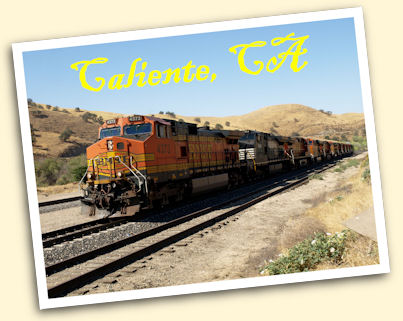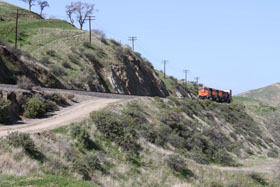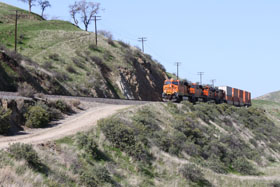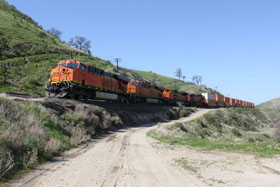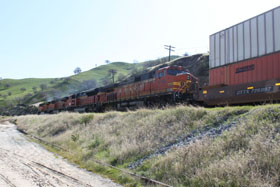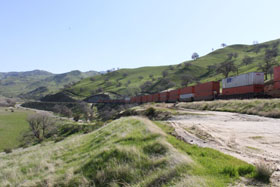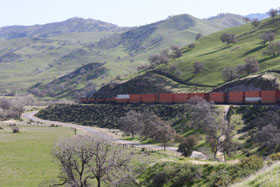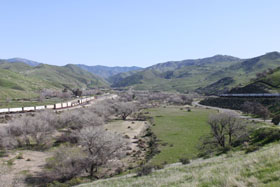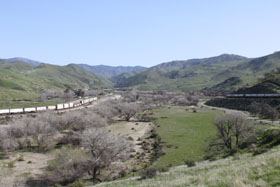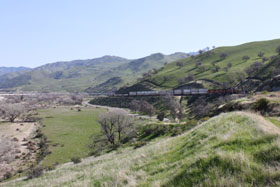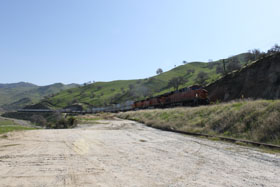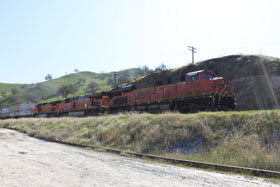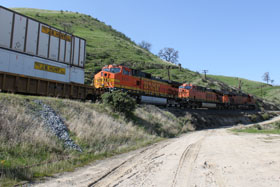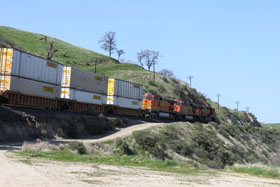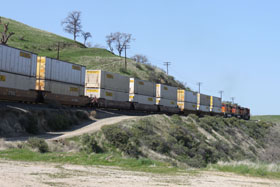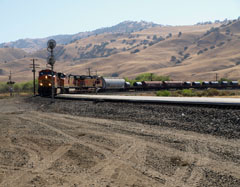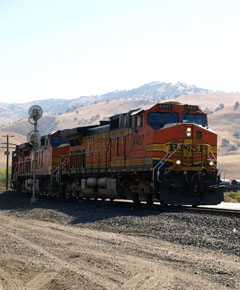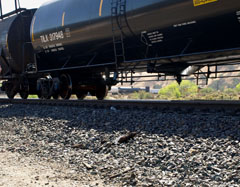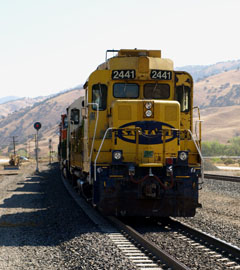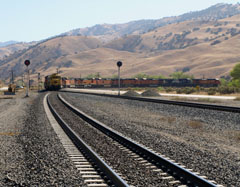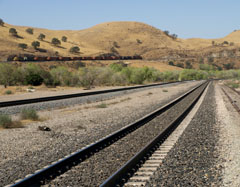The horseshoe curve at Caliente, CA, is on the Union Pacific's Mojave sub-division, part of the old Southern Pacific Los Angeles-San Francisco Valley Route, which was built between 1875 and 1876. The curve is about a 2 mile drive north from CA 58 on Bealville Road.
There is generally quite a bit of traffic in both directions on this part of the sub-division, both Union Pacific and BNSF, and there are many different spots at and around the curve to catch the action. Bealville Rd crosses the railroad line shortly after leaving CA 58 and then passes under it again just before reaching Caliente itself. These are good spots for taking photos, and the winding line and slow speed of most trains means you can catch them at both locations.
Caliente, CA, should not be confused with Caliente, NV, a small town with a disused passenger depot on the Union Pacific line between Los Angeles and Las Vegas. Once part of the old Los Angeles & Salt Lake City Railroad, the station building there has been turned into a small local museum.
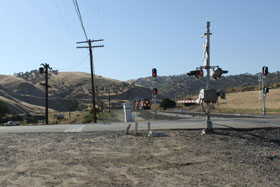
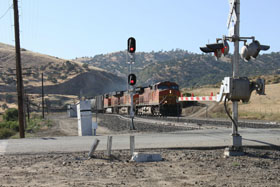
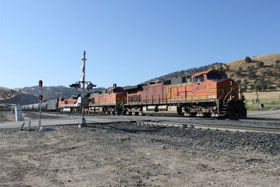
Above, BNSF GE C44-9W #4019, BNSF GE C44-9W #4157 and BNSF GE ES44DC #7234 approaching and crossing the Bealville Rd rail crossing about half a mile north of Highway 58.
In the top photo, you can see the train of tankers stretching back up the hill.
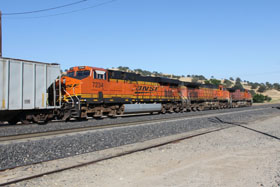
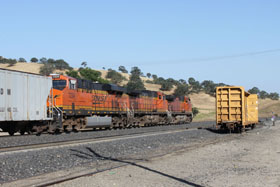
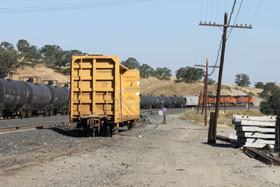
Above the three units pass the two sidings at this location and head towards Bakersfield. The Southern Pacific had a telegraph office and small depot here from 1876 to 1883.
There was also a post office from 1879 to 1881.
Below, BNSF GE C44-9W #4310, BNSF GE C44-9W #4633, BNSF EMD SD40-2 #6729, BNSF GE ES44DC #7273 and BNSF EMD SD40-2 #6877 are cut into the middle of the train.
Note the grain cars set between the units and tankers.
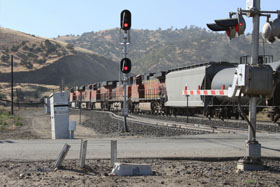
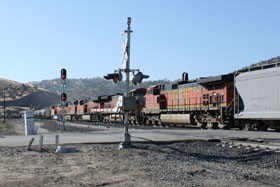
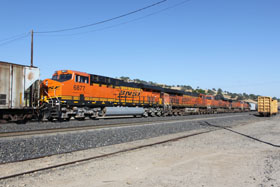
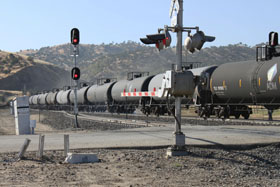
Above, the string of tankers. There was no helper on the rear. The blue haze is produced by the brake shoes, which are kept applied on the descent to prevent the train losing control.
Below, a tunnel and track about two miles east of Bealville.
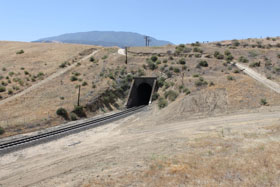
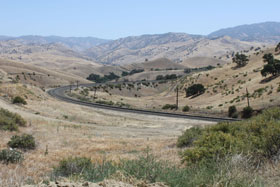
Below, #4019, #4157 and #7234 approaching the bridge over Bealville Rd near Caliente. The train has travelled just over four miles and dropped 240 feet from Bealville.
By road, the distance between the two locations is little over a mile.
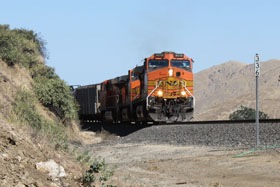
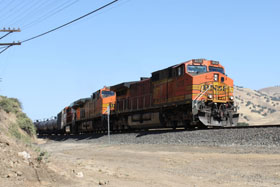
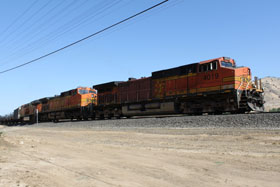
Below, #4019, #4157 and #7234 shown individually as they are just about to cross the bridge.
From here, the train will turn through 180°, crossing Caliente Creek to arrive at the valley floor about another fifty feet below.
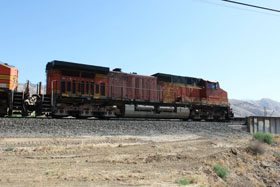
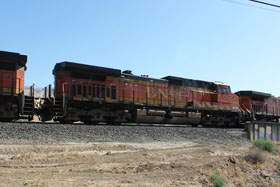
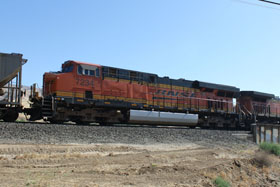
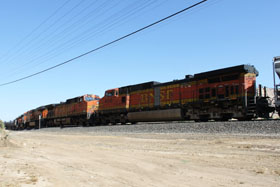
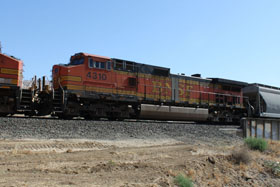
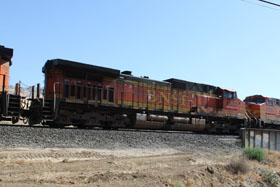
Top photo, #4310, #4633, #6729, #7273 and #6877 approaching the bridge. Lower two photos and on the right, photos of each of the five units as they are about to cross the bridge.
At this location, they are about twenty miles from Bakersfield.
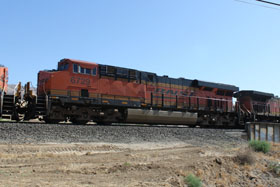
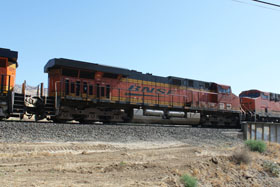
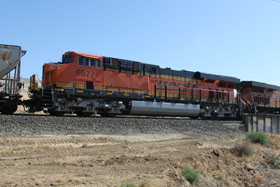
The line was completed in 1876.
It carried the Southern Pacific railway up from the San Joaquin Valley to the Mojave plateau through a narrow spur of hills that connects the southern end of the Sierra Nevadas and the Tehachapi Mountains.
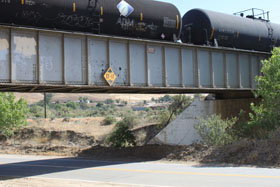
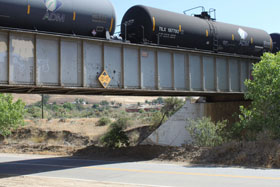
Above, you can see the five units turning through the 360° curve in the distance below the bridge span in the two views above. The rear part of the train is still passing over the bridge.
Caliente was originally named Allens Camp after a cattle rancher and settler named Gabriel Allen who arrived some time in the early 1870s.
Later, the name Agua Caliente, originating from hot springs in the
area, was proposed and may have
been used, but it conflicted with a town of the same name in Sonoma County. When the Southern Pacific arrived in 1875, the shortened name Caliente was adopted.
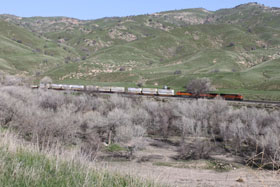
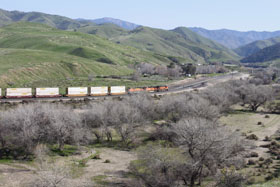
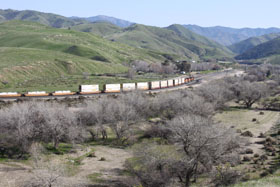
Above, an eastbound intermodal freight hauled by BNSF GE ES44DC #7450 and #7632, and GE C44-9W #5174 pulls onto the siding at Caliente to await a crossover with a westbound freight in the morning.

The panoramic view of the horseshoe curve above is looking east. It was made from an access road just off Caliente Bodfish Road, which runs along the base of the embankment on the right in this view. Caliente Creek has cut the cleft through the hills in the middle distance and runs across the valley floor. It is dry most of the year.
Caliente is 1,290 feet above sea level but, from here, the line begins its climb over the spur to the Mojave plateau. About eight miles southeast, after climbing 1,600 ft, it reaches the foot of the well known Tehachapi Loop (you can see photos of Tehachapi Loop on this website). Then, at Summit, just west of Mojave, CA, it crests the spur at 4,030 ft and starts a gentle drop to the Mojave plateau.
In 1879, three years after the line opened, Crofutt's New Overland Tourist and Pacific Coast Guide noted that there were several stores, a hotel, a large station building and freight warehouse here, with a considerable volume of
freight being re-shipped in wagons to the surrounding countryside (you can see Crofutt's New Overland Tourist on the books and manuals page of this website). Daily stage coaches also departed from Caliente to Havillah, twenty-five miles south on Caliente Bodfish Rd, and for Kernville, forty-five miles north.
Today, there is very little road traffic, and all that remains are a few farm houses and a small general store that doubles as the local post office.
The photos above were also taken from just off Caliente Bodfish Road. This is an excellent location to catch the action. As well as being close to the trains, you get great views of the curve.
With the westbound train having cleared the single line, the eastbound train starts into the curve heading towards Bakersfield.
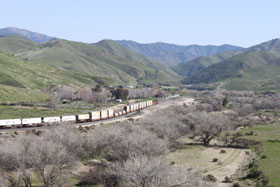

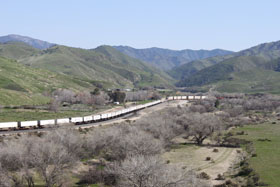
The dry creek bed strewn with wild oaks in the foreground of these views is Caliente Creek.
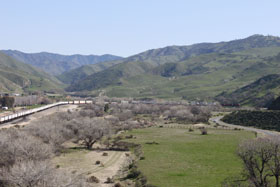
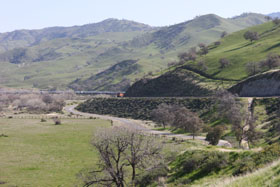
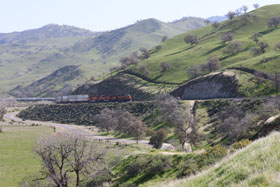
As the eastbound train climbs out of the valley, BNSF GE ES44DC #7450, BNSF GE ES44DC #7632 and GE BNSF C44-9W #5174's engines are roaring. Plumes of blue exhaust drape the valley, and this is where the real work begins! Over the next twenty-five miles, they will have to haul their load up a further 2,740 ft on a grade that averages just over 2% the entire distance.
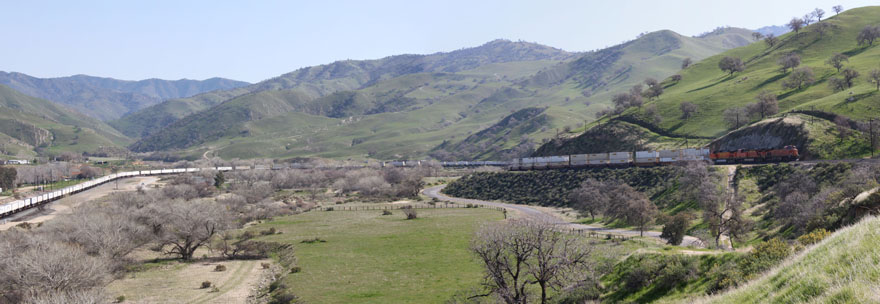
ES44DC indicates that the two lead locomotives are GE Transportation Systems Evolution Series, six axle, 4,400 hp, DC traction units powered by GE GEVO engines. They were designed to meet the US Environmental Protection Agency's Tier 2 locomotive emissions standards, which came into force in 2005. Depending on the customer's preferences, the units can be equipped with either AC or DC traction motors and, as well as a healthy US market, they have been exported to China, Australia, Brazil and Kazakhstan.
BNSF is one of the main users of the the Evolution Series. At the time of last updating this page, BNSF rostered seven hundred and twenty-six ES44AC units, forty-eight ES44C4 units and seven hundred and twenty-one ES44DC units.
Above, the triple header leaves the curve. There is both BNSF and UP action on the curve, although all the photos on this page are of BNSF units.
Be warned, however, there are no food or gas stations at Caliente: the nearest are nine miles away in Keene. The curve is about a one hundred and twenty mile drive from Los Angeles, so you can make it a day's outing from there. Alternatively, there are hotels in the town of Tehachapi about twenty miles south east on CA 58, or Bakersfield is just twenty-seven miles west.
Twenty minutes after the eastbound train has cleared the curve, a double stack westbound freight edges down.
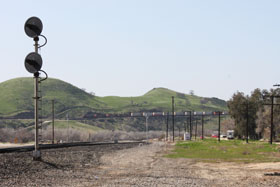
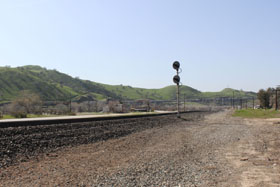
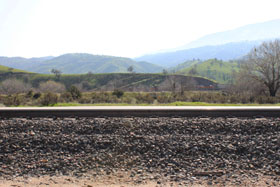
This sequence of photos was taken from Caliente Creek Road just to the east of the Caliente Bodfish Road railroad crossing.
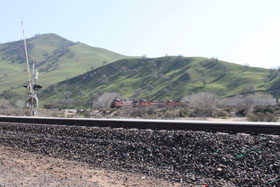
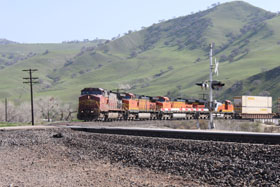
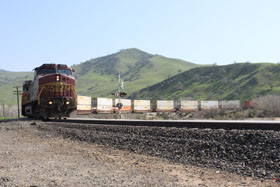
ATSF GE C40-9W #626 leads BNSF GE C40-9W #5447, #5017 and #5417 as they round the curve, cross Caliente Creek and enter the Caliente Bodfish Road railroad crossing.
#626 sports the old Santa Fe warbonnet.
Having dropped some 200' from the hills above Caliente Creek, the line swings through 180° to arrive at the valley floor. The train then rolls east towards Bakersfield.
On the right in the photos below, the site of the long gone Caliente depot.
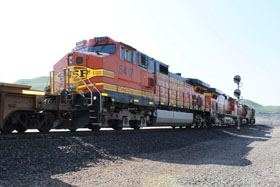
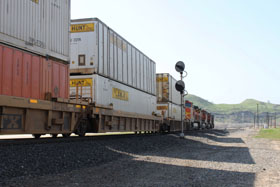
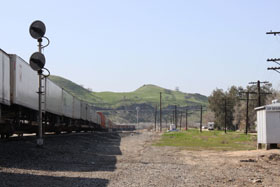
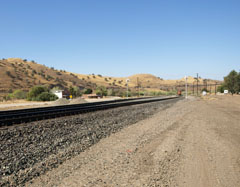
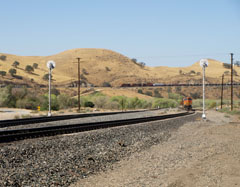
Above, it's mid morning and an eastbound mixed freight train crawls down the grade towards Caliente.
Meanwhile, below, a line of twelve helpers are waiting to move west out of the siding.
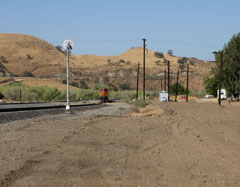
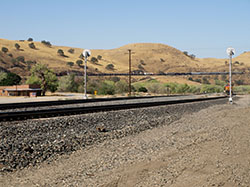
Below, the triple header, hauling a mixed consist, negotiates the curve and crosses Caliente Creek with BNSF GE C44-9W #4407 in the lead.
BNSF GE C44-9W #4847 and #5380 make up the trio.
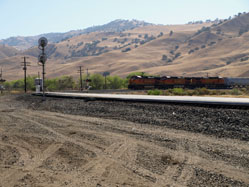
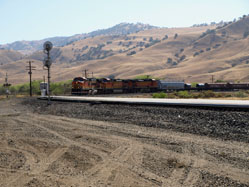
After taking the curve, the train continues east towards Bakersfield.
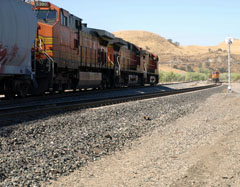
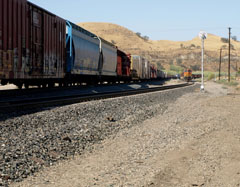
Below, BNSF GE C44-9W #5009 pushes the last of the consist into the curve at the far end of the valley.
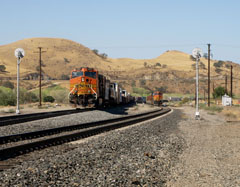
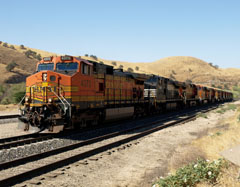
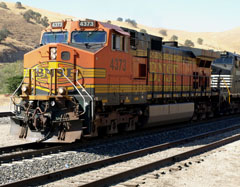
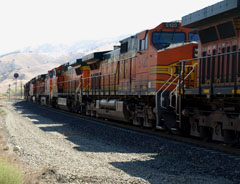
Once the east bound main has cleared, the helpers head out.
It's a mixed bunch. BNSF GE C44-9W #4373 is in the lead with Norfolk Southern liveried GE C40-9W #8918 and BNSF GE C44-9W #5120 behind.
